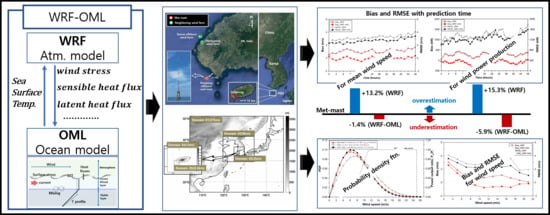Verification of the Reliability of Offshore Wind Resource Prediction Using an Atmosphere–Ocean Coupled Model
Abstract
1. Introduction
2. Materials and Methods
2.1. Daejong Site and Meteorological Mast Description
2.2. Atmospheric–Ocean Coupled Model (WRF-OML)
2.2.1. Atmospheric Model (WRF)
2.2.2. Ocean Mixed Layer Model (OML)
3. Results
4. Discussion
4.1. Basic Wind Resource Assessment
4.2. Wind Speed Prediction Results of WRF and WRF-OML Models at the Hub Height
4.3. Energy Production Prediction Results of WRF and WRF-OML Models
5. Conclusions
- Comparing the wind speed prediction, the average bias was 1.09 for the WRF model and −0.07 for the WRF-OML model. The root mean square error (RMSE) was 2.88 for the WRF model and 2.45 for the WRF-OML model. Thus, the WRF-OML model has a better prediction performance than the WRF model;
- Both models showed overestimation tendencies at low wind speeds (less than 4 m/s) and provided relatively stable prediction between 6 and 16 m/s, with increased error as the prediction time increased;
- Comparing the energy production prediction by prediction time, the average error between the WRF-OML and WRF models was 202 kW for the bias and 107 kW for the RMSE, thus confirming a better performance from the WRF-OML model;
- In comparison to the met-mast data, the WRF model overestimated the wind speed and annual energy production by 13.2% and 15.3%, respectively, while the WRF-OML model underestimated them by 1.4% and 5.9%, respectively. Consequently, the wind speed and energy prediction reliability of the WRF-OML model were 11.8% and 9.4% higher than that of the WRF model;
- Since the WRF-OML model was only validated for the Daejeong offshore site in this work, it is necessary to investigate further for other offshore sites with various conditions to further validate the model.
Author Contributions
Funding
Conflicts of Interest
References
- Chancham, C.; Waewsak, J.; Gagnon, Y. Offshore wind resource assessment and wind power plant optimization in the Gulf of Thailand. Energy 2017, 139, 706–731. [Google Scholar] [CrossRef]
- Wang, Y.H.; Walter, R.K.; White, C.; Farr, H.; Ruttenberg, B.I. Assessment of surface wind datasets for estimating offshore wind energy along the Central California Coast. Renew. Energy 2019, 133, 343–353. [Google Scholar] [CrossRef]
- Carvalho, D.; Rocha, A.; Gómez-Gesteira, M.; Santos, C. A sensitivity study of the WRF model in wind simulation for an area of high wind energy. Environ. Model. Softw. 2012, 33, 23–34. [Google Scholar] [CrossRef]
- Cavalho, D.; Rocha, A.; Gómez-Gesteira, M.; Santos, C.S. Sensitivity of the WRF model wind simulation and wind energy production estimates to planetary boundary layer parameterizations for onshore and offshore area in the Iberian Peninsula. Appl. Energy 2014, 135, 234–246. [Google Scholar] [CrossRef]
- Mattar, C.; Borvarán, D. Offshore wind powers simulation by using WRF in the central coast of Chile. Renew. Energy 2016, 94, 22–31. [Google Scholar] [CrossRef]
- Di, Z.; Ao, J.; Duan, Q.; Wang, J.; Gong, W.; Shen, C.; Gan, Y.; Liu, Z. Improving WRF model turbine-height wind-speed forecasting using a surrogate-based automatic optimization method. Atmos. Res. 2019, 226, 1–16. [Google Scholar] [CrossRef]
- Park, R.S.; Cho, Y.K.; Choi, B.J.; Song, C.H. Implications of sea surface temperature deviations in the prediction of wind and precipitable water over the Yellow Sea. J. Geophys. Res. 2011, 116, D17. [Google Scholar] [CrossRef]
- Schade, L.R.; Emanuel, K.A. The ocean’s effect on the intensity of tropical cyclones: Results from a simple cou- pled atmosphere-ocean model. J. Atmos. Sci. 1999, 56, 642–651. [Google Scholar] [CrossRef]
- Kawai, Y.; Otsuka, K.; Kawamura, H. Study on diurnal sea surface warming and a local atmospheric circulation over Mutsu Bay. J. Meteorol. Soc. Jpn. 2006, 84, 725–744. [Google Scholar] [CrossRef]
- Dai, A.; Trenberth, K.E. The diurnal cycle and its depiction in the community climate system model. J. Clim. 2003, 17, 930–951. [Google Scholar] [CrossRef]
- Noh, Y.; Lee, E.; Kim, D.H.; Hong, S.Y.; Kim, M.J.; Ou, M.L. Prediction of the diurnal warming of sea surface temperature using an atmosphere-ocean mixed layer coupled model. J. Geophys. Res. 2011, 116, C11. [Google Scholar] [CrossRef]
- Chang, S.W.; Anthes, R.A. The mutual response of the tropical cyclone and the ocean. J. Phys. Oceanogr. 1979, 9, 128–135. [Google Scholar] [CrossRef]
- Lee, C.Y.; Chen, S.S. Symmetric and asymmetric structures of hurricane boundary layer in coupled atmosphere-wave-ocean models and observations. J. Atmos. Sci. 2012, 69, 3576–3594. [Google Scholar] [CrossRef]
- NCAR. ARW Modeling System V3.9 User’s Guide; National Center for Atmospheric Research: Boulder, CO, USA, 2017. [Google Scholar]
- Mellor, G.L.; Yamada, T. Development of a turbulence closure model for geophysical fluid problems. Rev. Geophys. Space Phys. 1982, 20, 851–875. [Google Scholar] [CrossRef]
- Jiménez, P.A.; Dudhia, J.; González-Rouco, J.F.; Navarro, J.; Montávez, J.P.; García-Bustamante, E. A revised scheme for the WRF surface layer formulation. Mon. Weather Rev. 2012, 140, 898–918. [Google Scholar] [CrossRef]
- Chen, F.; Dudhia, J. Coupling an advanced land surface–hydrology model with the Penn State-NCAR MM5 Modeling system. Part II: Preliminary model validation. Mon. Weather Rev. 2001, 129, 587–604. [Google Scholar] [CrossRef]
- Mlawer, E.J.; Taubman, S.J.; Brown, P.D.; Iacono, M.J.; Clough, S.A. Radiative transfer for inhomogeneous atmospheres: RRTM, a validated correlated-k model for the longwave. J. Geophys. Res. Atmos. 1997, 102, 16663–16682. [Google Scholar] [CrossRef]
- Dudhia, J. Numerical study of convection observed during the winter monsoon experiment using a mesoscale two-dimensional model. J. Atmos. Sci. 1989, 46, 3077–3107. [Google Scholar] [CrossRef]
- Mohan, G.M.; Srinivas, C.V.; Naidu, C.V.; Baskaran, R.; Venkatraman, B. Real-time numerical simulation of tropical cyclone Nilam with WRF: Experiments with different initial conditions, 3D-Var and ocean mixed layer model. Nat. Hazards 2015, 77, 597–624. [Google Scholar] [CrossRef]
- Price, J.F.; Weler, R.A.; Pinkel, R. Diurnal cycling: Observations and models of the upper ocean response to diurnal heating, cooling, and wind mixing. J. Geophys. Res. 1986, 91, 8411–8427. [Google Scholar] [CrossRef]
- Price, J.F. Upper ocean response to a hurricane. J. Phys. Oceanogr. 1981, 11, 153–175. [Google Scholar] [CrossRef]
- Wu, C.C.; Tu, W.T.; Pun, I.F.; Lin, I.I.; Peng, M.S. Tropical cyclone-ocean interaction in Typhoon Megi (2010)—A synergy study based on ITOP observations and atmosphere-ocean coupled model simulations. J. Geophys. Res. 2016, 121, 153–167. [Google Scholar] [CrossRef]
- Pollard, R.T.; Rhines, P.B.; Thompson, R.Y. The deepening of the wind-mixed layer. Geophys. Fluid Dyn. 1973, 4, 381–404. [Google Scholar] [CrossRef]
- Manwell, J.F.; Rogers, A.L.; McGowan, J.G.; Bailey, B.H. An offshore wind resource assessment study for New England. Renew. Energy 2002, 27, 175–187. [Google Scholar] [CrossRef]
- Powell, M.D.; Vickery, P.J.; Reinhold, T.A. Reduced drag coefficient for high wind speed in tropical cyclones. Nature 2003, 422, 279–283. [Google Scholar] [CrossRef] [PubMed]
- Valsaraj, K.T.; Melvin, E.M. Elements of Environmental Engineering Thermodynamics and Kinetics, 3rd ed.; CRC Press: Boca Raton, FL, USA, 2009; pp. 454–456. ISBN 978-1-4200-7820-6. [Google Scholar]
- Cheang, E.H.; Moon, C.J.; Jeong, M.S.; Jo, K.P.; Park, G.Y. The study for calculating the geometric average height of Deacon equation suitable to the domestic wind correction methodology. J. Korean Sol. Energy Soc. 2010, 30, 9–14. [Google Scholar]
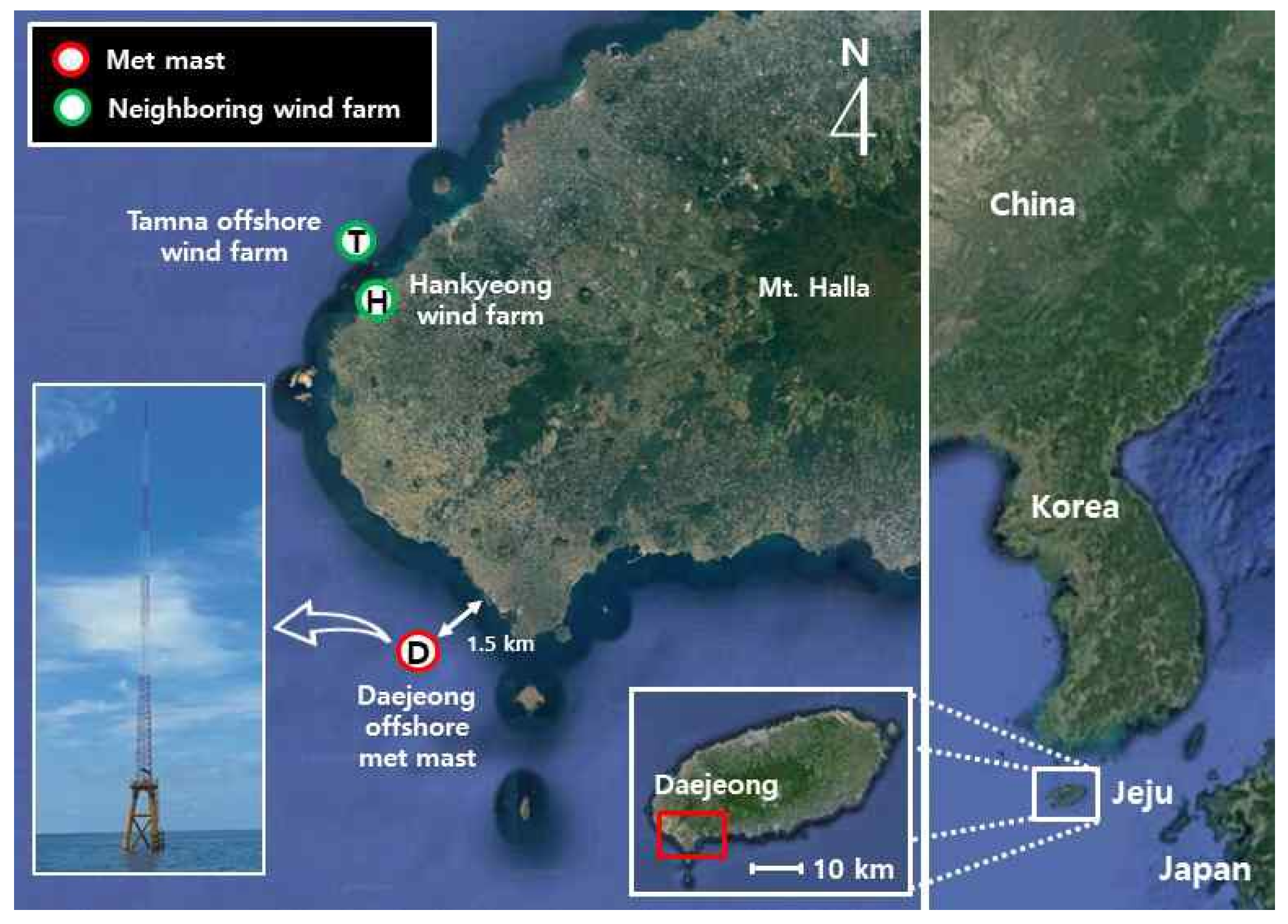
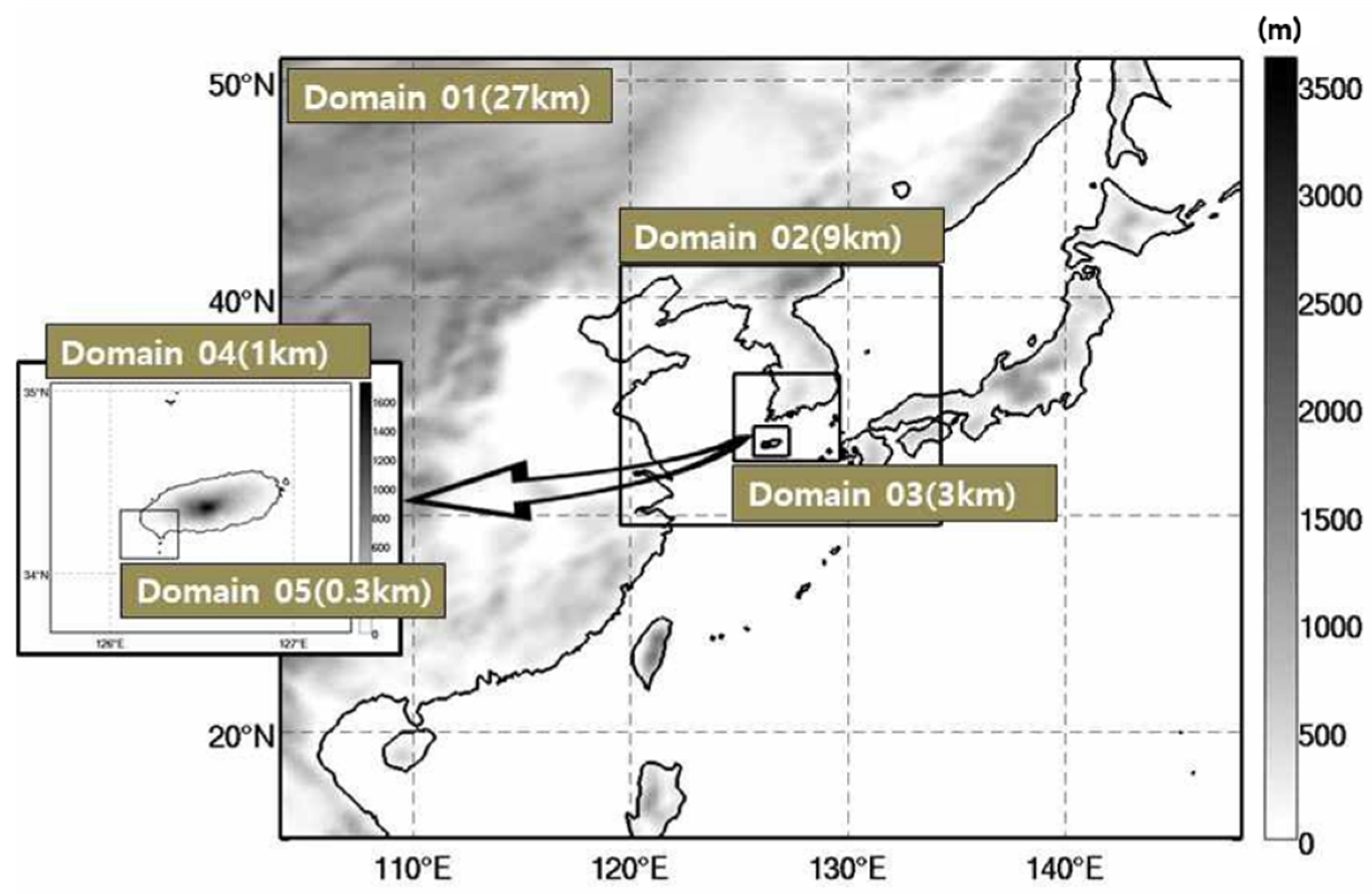
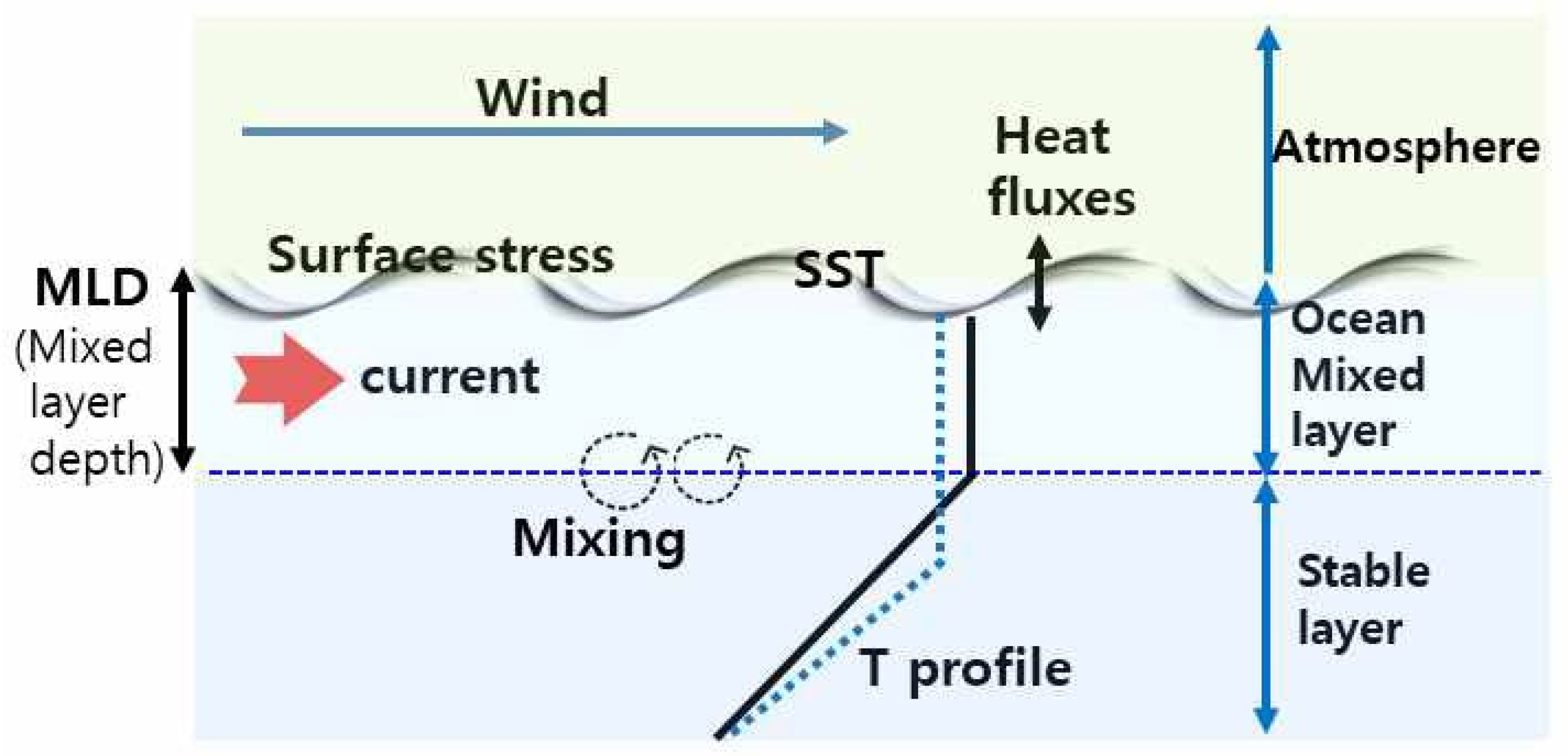


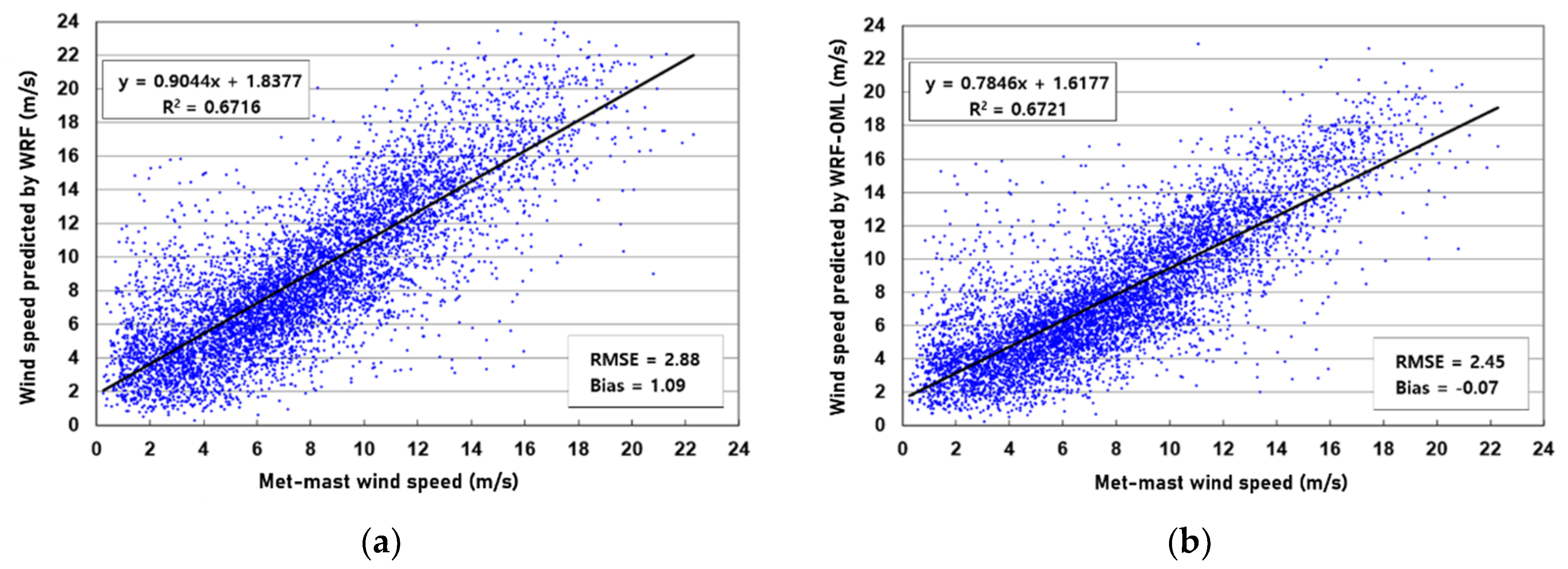
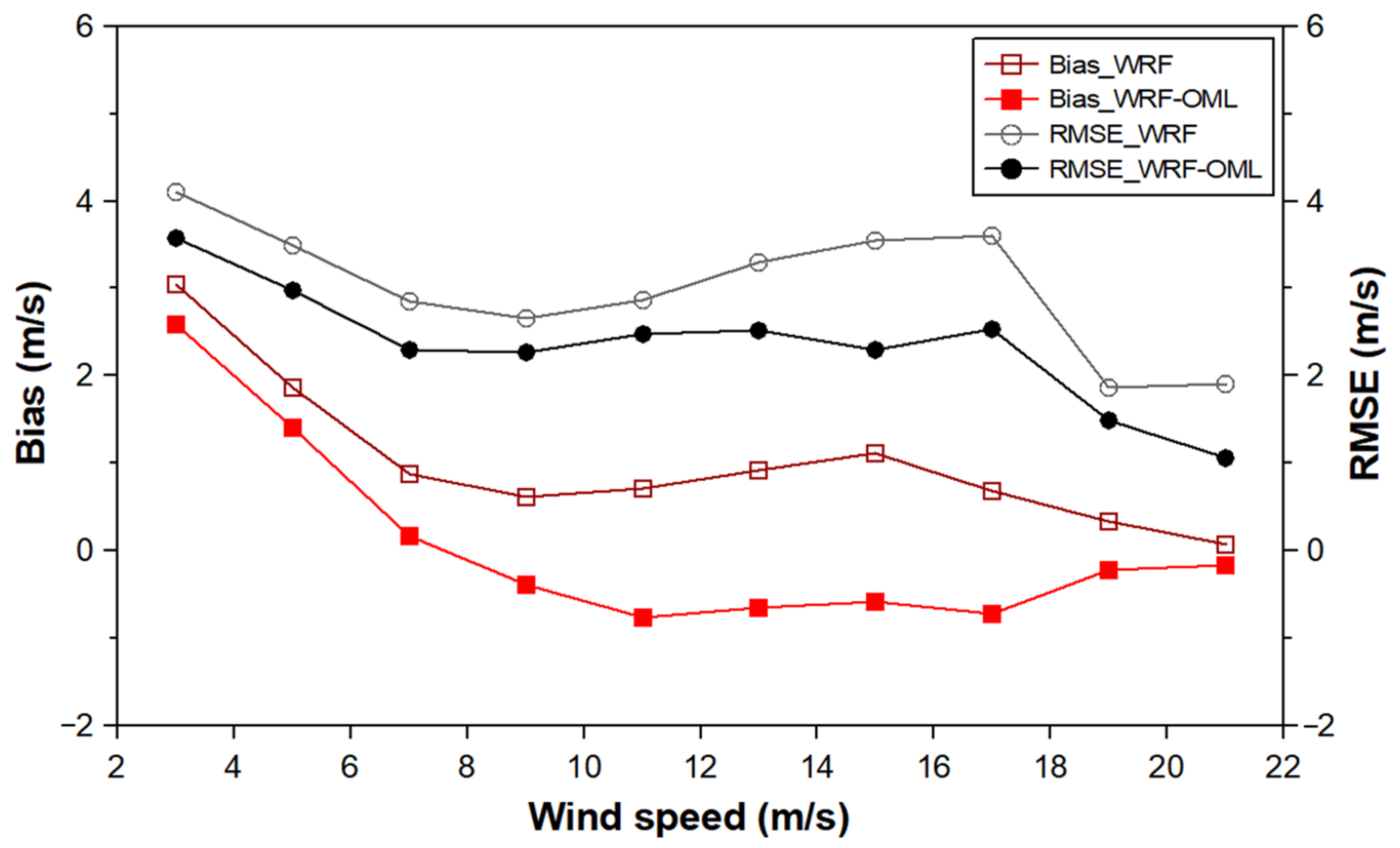
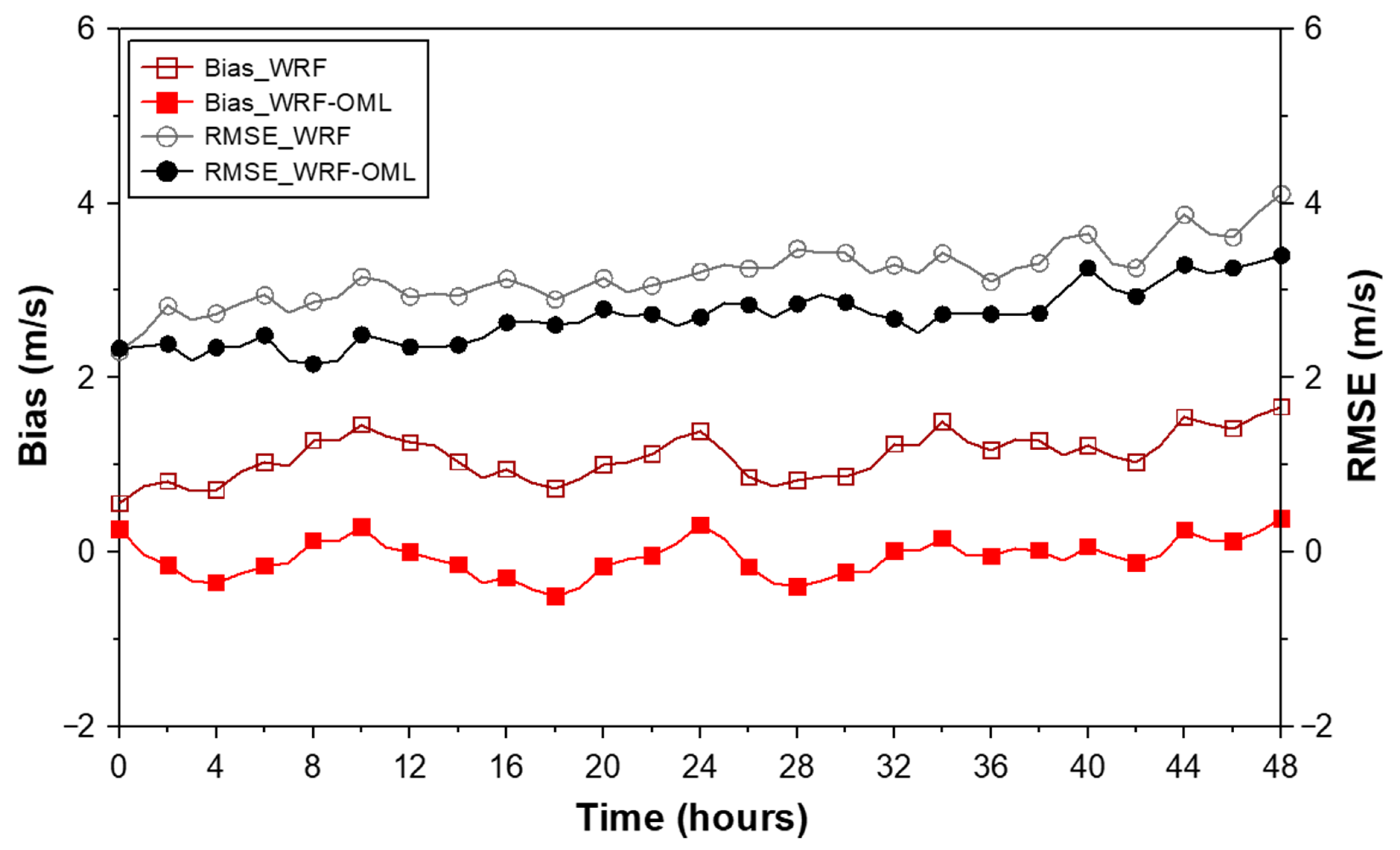

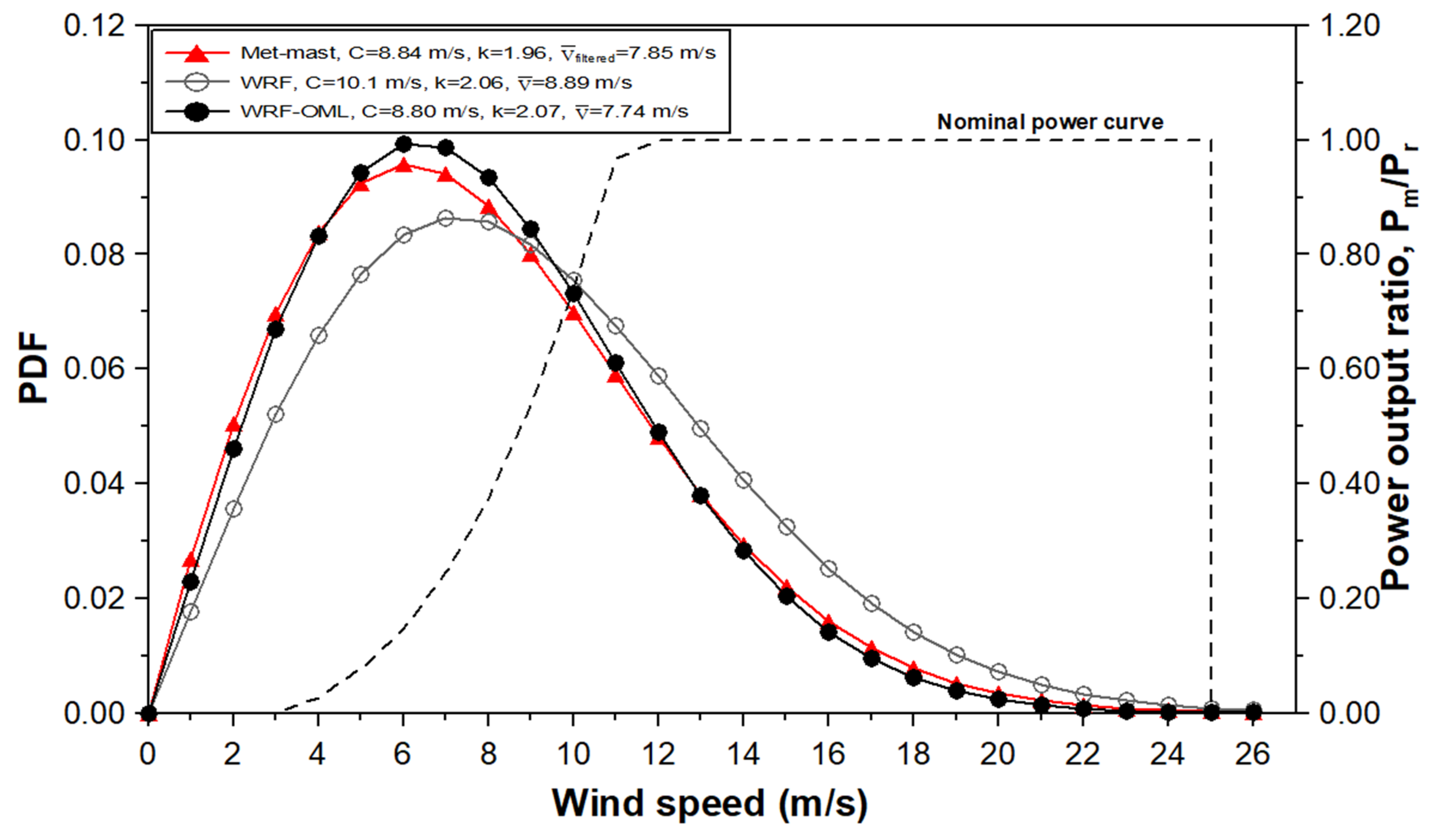

| Items | Wind Sensors | |
|---|---|---|
| Anemometer | Wind Vane | |
| Model | Thies First class | Thies First class |
| Measurement range | 0–75 m/s | 0–360° |
| Accuracy | 0.2 m/s | 1.5° |
| Stating threshold | 0.3 m/s | 0.2 m/s |
| Operating temperature | −50–+80 °C | −50–+80 °C |
| Heights | 99 m, 94 m, 88 m, 80 m, 60 m, 20 m | 94 m, 88 m, 80 m, 60 m |
| Tower location | 33.19° N, 126.28° E | |
| Variable | Physics Scheme |
|---|---|
| Microphysics | WDM 6 scheme |
| Planetary boundary layer | Meller–Yamada–Janjic scheme |
| Surface layer | Monin–Obulkhov (Janjic) scheme |
| Land surface | Noah-MP land-surface model |
| Longwave radiation | RRTM scheme |
| Shortwave radiation | Dudhia scheme |
| Period | Number of Data Point | |||
|---|---|---|---|---|
| Met-Mast | Filtered | WRF (Recovery Rate (%)) | WRF-OML (Recovery Rate (%)) | |
| August 2015 | 744 | 696 | 1392 (0.93) (93.5) | 1392 (0.93) (93.5) |
| September 2015 | 720 | 384 | 768 (0.53) (53.3) | 768 (0.53) (53.3) |
| October 2015 | 744 | 624 | 1248 (0.84) (83.9) | 1248 (0.84) (83.9) |
| November 2015 | 720 | 696 | 1392 (0.97) (96.7) | 1392 (0.97) (96.7) |
| December 2015 | 744 | 504 | 1008 (0.68) (67.7) | 1008 (0.68) (67.7) |
| January 2016 | 744 | 648 | 1296 (0.87) (87.1) | 1296 (0.87) (87.1) |
| February 2016 | 696 | 672 | 1344 (0.97) (96.6) | 1344 (0.97) (96.6) |
| March 2016 | 744 | 696 | 1392 (0.94) (93.5) | 1392 (0.94) (93.5) |
| April 2016 | 720 | 504 | 1008 (0.70) (70.0) | 1008 (0.70) (70.0) |
| May 2016 | 744 | 240 | 480 (0.32) (32.3) | 480 (0.32) (32.3) |
| June 2016 | 720 | 600 | 1200 (0.83) (83.3) | 1200 (0.83) (83.3) |
| July 2016 | 744 | 480 | 960 (0.65) (64.5) | 960 (0.65) (64.5) |
| Sum (Recovery Rate (%)) | 8784 (100.0) | 6744 (76.8) | 13,488 (76.8) | 13,488 (76.8) |
| Period | Met-Mast | WRF | WRF-OML | ||
|---|---|---|---|---|---|
| Wind Speed (m/s) | Wind Speed (m/s) | Ratio (%) | Wind Speed (m/s) | Ratio (%) | |
| August 2015 | 5.60 | 6.52 | 116.4 | 5.71 | 102.0 |
| September 2015 | 7.45 | 8.57 | 115.0 | 7.48 | 100.4 |
| October 2015 | 7.12 | 7.88 | 110.7 | 6.92 | 97.2 |
| November 2015 | 8.06 | 9.56 | 118.6 | 8.34 | 103.5 |
| December 2015 | 9.16 | 11.00 | 120.1 | 9.41 | 102.7 |
| January 2016 | 10.09 | 11.64 | 115.4 | 10.24 | 101.5 |
| February 2016 | 10.62 | 11.68 | 110.0 | 10.32 | 97.2 |
| March 2016 | 8.07 | 9.63 | 119.3 | 7.95 | 98.5 |
| April 2016 | 6.53 | 7.65 | 117.2 | 6.53 | 100.0 |
| May 2016 | 8.85 | 9.36 | 105.8 | 8.13 | 91.9 |
| June 2016 | 5.91 | 6.11 | 103.4 | 5.45 | 92.2 |
| July 2016 | 6.71 | 7.14 | 106.4 | 6.44 | 96.0 |
| Total | 7.85 | 8.89 | 113.2 | 7.74 | 98.6 |
| Period | Met-Mast | WRF | WRF-OML | ||
|---|---|---|---|---|---|
| Power Production (kW) | Power Production (kW) | Ratio (%) | Power Production (kW) | Ratio (%) | |
| August 2015 | 774.29 | 1062.87 | 137.3 | 724.95 | 93.6 |
| September 2015 | 831.77 | 959.53 | 115.4 | 784.92 | 94.4 |
| October 2015 | 1271.69 | 1386.24 | 109.0 | 1102.76 | 86.7 |
| November 2015 | 1729.84 | 2196.71 | 127.0 | 1749.55 | 101.1 |
| December 2015 | 1623.35 | 1954.01 | 120.4 | 1643.49 | 101.2 |
| January 2016 | 2306.01 | 2586.51 | 112.2 | 2402.99 | 104.2 |
| February 2016 | 2502.44 | 2784.71 | 111.3 | 2406.58 | 96.2 |
| March 2016 | 1769.73 | 2058.19 | 116.3 | 1611.97 | 91.1 |
| April 2016 | 866.58 | 1102.16 | 127.2 | 801.11 | 92.4 |
| May 2016 | 716.08 | 730.40 | 102.0 | 551.74 | 77.1 |
| June 2016 | 837.99 | 823.95 | 98.3 | 616.03 | 73.5 |
| July 2016 | 855.70 | 900.81 | 105.3 | 733.62 | 85.7 |
| Total | 16,085.47 | 18,546.09 | 115.3 | 15,129.71 | 94.1 |
© 2020 by the authors. Licensee MDPI, Basel, Switzerland. This article is an open access article distributed under the terms and conditions of the Creative Commons Attribution (CC BY) license (http://creativecommons.org/licenses/by/4.0/).
Share and Cite
Kang, M.; Ko, K.; Kim, M. Verification of the Reliability of Offshore Wind Resource Prediction Using an Atmosphere–Ocean Coupled Model. Energies 2020, 13, 254. https://doi.org/10.3390/en13010254
Kang M, Ko K, Kim M. Verification of the Reliability of Offshore Wind Resource Prediction Using an Atmosphere–Ocean Coupled Model. Energies. 2020; 13(1):254. https://doi.org/10.3390/en13010254
Chicago/Turabian StyleKang, Minhyeop, Kyungnam Ko, and Minyeong Kim. 2020. "Verification of the Reliability of Offshore Wind Resource Prediction Using an Atmosphere–Ocean Coupled Model" Energies 13, no. 1: 254. https://doi.org/10.3390/en13010254
APA StyleKang, M., Ko, K., & Kim, M. (2020). Verification of the Reliability of Offshore Wind Resource Prediction Using an Atmosphere–Ocean Coupled Model. Energies, 13(1), 254. https://doi.org/10.3390/en13010254





